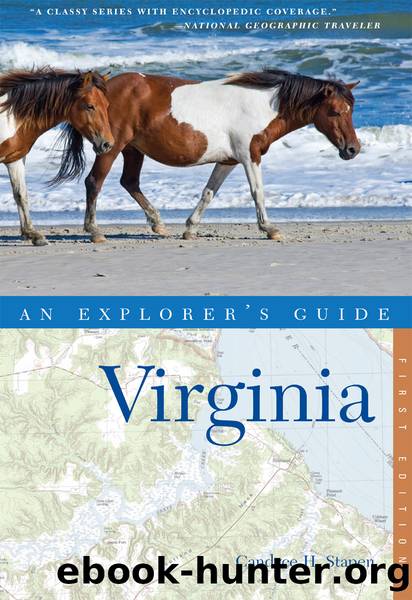Explorer's Guide Virginia (Explorer's Complete) by Candyce H. Stapen

Author:Candyce H. Stapen
Language: eng
Format: epub
Publisher: Countryman Press
Published: 2011-07-14T16:00:00+00:00
* * *
VINTAGE: VIRGINIA
Compared to California, Virginia seems to be a newcomer to winemaking, but its history with the fruit of the vine goes back to Jamestown’s very first settlers. In 1607, when these pioneers arrived, part of their mission was to create a thriving wine industry, and each household was required to grow at least 10 grapevines. A visit to Monticello, Thomas Jefferson’s home in Charlottesville, illustrates the grand effort he put forth in creating fine wines on his estate—though he was never successful, due to disease among his vines. Finally, in the 19th century, Virginia vineyards began to flourish. The native Norton grape and others were cultivated, and the industry began to grow. A wine made from Norton grapes won “best red wine of all nations” at the Vienna World’s Fair in 1873.
Then came Prohibition. It took decades to recover from that early 20th-century ban on all alcohol, but finally winemaking in Virginia began to creep back in the 1970s. Now there are almost 170 wineries in the state, and more than 50 of them are in Northern Virginia. The state’s vintners compete with the best in the country, winning national and international awards, and the industry is considered up and coming by some wine connoisseurs.
Virginia wines are typically styled after old-world vintages, as the climate in Virginia mirrors that of much of Europe. Especially distinctive are the Virginia Viognier, a dry white wine, along with Cabernets and Merlots. The state’s small vineyards, usually run by the same families that first established them, are also reminiscent of the European approach to winemaking.
The Virginia Wine Board has created a dozen wine trails across the state; a map of wineries with detailed directions, information about hours of operation, and contact information (including Web sites) is available through most tourist bureaus (see “Guidance”) or directly from the Wine Board (www.virginiawine.org). Almost all the wineries welcome visitors with tasting rooms and tours, and many provide picnic areas and/or have food available for purchase.
Download
This site does not store any files on its server. We only index and link to content provided by other sites. Please contact the content providers to delete copyright contents if any and email us, we'll remove relevant links or contents immediately.
Giovanni's Room by James Baldwin(5878)
The Plant Paradox by Dr. Steven R. Gundry M.D(2040)
The Stranger in the Woods by Michael Finkel(1924)
Miami by Joan Didion(1882)
DK Eyewitness Top 10 Travel Guides Orlando by DK(1814)
Vacationland by John Hodgman(1776)
Trail Magic by Trevelyan Quest Edwards & Hazel Edwards(1760)
Wild: From Lost to Found on the Pacific Crest Trail by Cheryl Strayed(1736)
INTO THE WILD by Jon Krakauer(1724)
The Twilight Saga Collection by Stephenie Meyer(1720)
Nomadland by Jessica Bruder(1684)
Birds of the Pacific Northwest by Shewey John; Blount Tim;(1604)
Portland: Including the Coast, Mounts Hood and St. Helens, and the Santiam River by Paul Gerald(1581)
The Last Flight by Julie Clark(1492)
On Trails by Robert Moor(1477)
Deep South by Paul Theroux(1475)
Trees and Shrubs of the Pacific Northwest by Mark Turner(1426)
Blue Highways by William Least Heat-Moon(1377)
1,000 Places to See in the United States and Canada Before You Die (1,000 Places to See in the United States & Canada Before You) by Patricia Schultz(1294)
